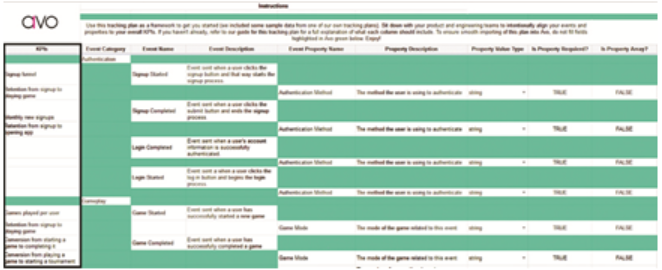To understand how users interact with your product, it’s important to track their behavior, ensuring compliance with all privacy and data governance laws. Tracking user behavior helps you make your product better.
Before setting up tracking, develop a tracking plan. A data tracking plan is a document that outlines the events the business needs to track and the tracking methods it will use. It will cover details like where events need to go in the code base and why they are necessary from a business perspective.
Tracking plans serve multiple purposes. First, they promote alignment and ensure that all stakeholders are on the same page regarding data collection and implementation. Additionally, these plans facilitate seamless utilization and comprehension of the collected data by engineering, product, marketing, and analytics teams. Ideally, your tracking plan should be in a format like Google Sheets or Wiki, which is easily shared and updated by multiple stakeholders (see Figure 5.8).

Figure 5.8: Tracking Plan Template by Avo (Source: https://www.avo.app/blog/avos-ultimate-tracking-plan-template-w-downloadable-worksheet)
A good tracking plan does the following:
- Summarizes which events and properties need to be added
- Justifies why they need to be tracked
- Details where in the code base they need to be added
- Informs stakeholders of progress/completion
With the define and design phase under your belt, you are now ready to start the build phase. Your team should be prepared with the prioritized use cases that will be built during the first build phase. Data assessment reports will provide insights into the current state and the required effort to reach the desired state.
If any of your use cases involved tracking user events, your team will need to implement the tracking plan that was created during the define phase. We have discussed user tracking, tracking plans, and event data in Chapter 2. Now, let’s move on to the implementation of the tracking plan.

